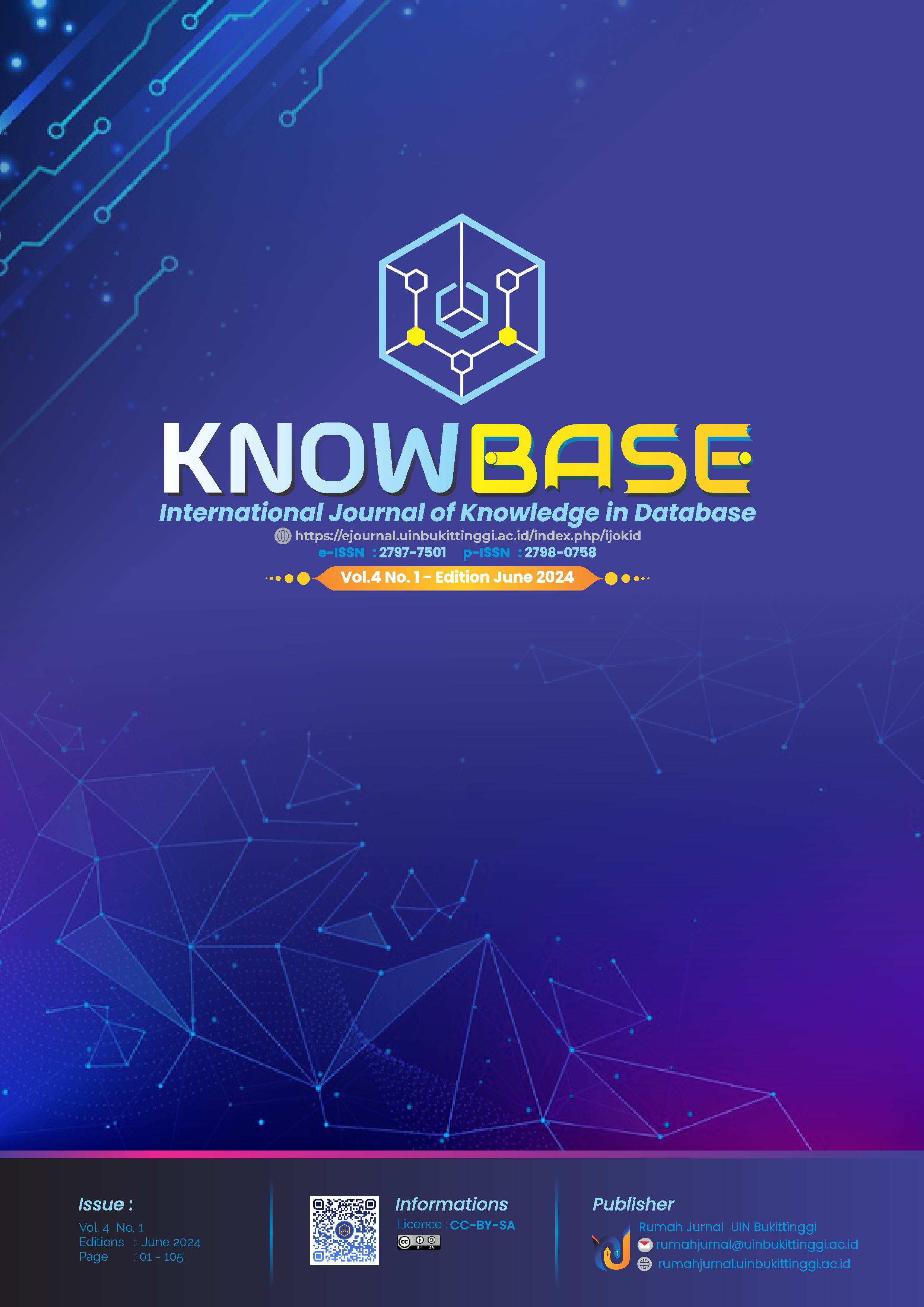Application of Graph Colouring Algorithm in Course Scheduling Process
DOI:
https://doi.org/10.30983/knowbase.v4i1.8136Keywords:
Graph Colouring Algorithm, Scheduling, IncrementalAbstract
Scheduling is a crucial aspect in every occurrence, ensuring that all processes are orderly. Gema Nusantara Bukittinggi Health Vocational School currently utilizes Microsoft Excel for managing subject scheduling, which often leads to scheduling conflicts. The objective of this research is to develop a web-based subject scheduling system for Gema Nusantara Bukittinggi Health Vocational School. The outcome of this research is a web-based subject scheduling system that is valid, practical, and effective, thereby serving as a useful tool for subject scheduling. This research is classified as research and development (R&D). The system development follows an incremental model with four stages: analysis, design, coding, and testing. The product was evaluated through three types of tests: validity, practicality, and effectiveness. The validity test, conducted with three experts, yielded a value of 0.80, indicating validity. The practicality test, carried out with three practitioners, resulted in a value of 0.97, signifying high practicality. The effectiveness test, involving fifteen teachers, achieved a value of 0.95, demonstrating high effectiveness. Based on the product testing results, it can be concluded that the research product, which is a web-based scheduling system, is suitable for use in the subject scheduling process at Gema Nusantara Bukittinggi Health Vocational School
References
Y. Kurniawan, “Sistem Informasi Penjadwalan Mata Pelajaran Pada Smp,” vol. 2, no. 5, pp. 1449–1453, 2023.
Zulmahendra and S. Derta, “Penjadwalan Kuliah Otomatis Menggunakan Algoritma Genetika,” JSI J. Sist. Inf., vol. 12, no. 2, p. 2020, 2020, [Online]. Available: http://ejournal.unsri.ac.id/index.php/jsi/index
A. P. S. Wardani and A. Syahputra, “Sistem Informasi Penjadwalan Kegiatan Mengajar Guru Pada SMP Negeri 1 Hamparan Perak Berbasis Online,” J. Comput. Digit. Bus., vol. 2, no. 1, pp. 1–10, 2023.
H. Budiman, “Penerapan Graph Colouring Untuk Merencanakan Jadwal”.
H. Septanto, K. M. A. Hakim, and A. F. Rizky, “Perancangan Sistem Informasi Penjadwalan Mengajar Dosen Teknik Informatika Universitas XYZ,” Tera, vol. 2, no. 1, pp. 57–66, 2022, [Online]. Available: http://jurnal.undira.ac.id/index.php/jurnaltera/Page
Z. Marzuki and H. A. Musril, “Perancangan Sistem Informasi Akademik Siswa Menggunakan Codeigniter 3 Di Smkn 4 Payakumbuh,” J. Edukasi Elektro, vol. 5, no. 1, pp. 49–55, 2021, doi: 10.21831/jee.v5i1.37190.
H. A. Musril and M. R. Darmawan, “Perancangan Sistem Pendaftaran Audiens Seminar Proposal di Institut Agama Islam Negeri ( IAIN ) Bukittinggi,” J. Teknol. dan Inf., vol. 11, no. 1, pp. 26–39, 2021, doi: 10.34010/jati.v11i1.
I. M. A. O. Gunawan, G. Indrawan, and S. Sariyasa, “Pengembangan Sistem Informasi Kemajuan Akademik Menggunakan Model Incremental Berbasis Evaluasi Usability Dan White Box Testing,” SINTECH (Science Inf. Technol. J., vol. 4, no. 1, pp. 67–78, 2021, doi: 10.31598/sintechjournal.v4i1.661.
Yulifda Elin Yuspita and M. Rezeki, “Sistem Informasi Pusat Pengaduan Pelayanan Masyarakat Menggunakan Work System Framework,” J. Tek. Mesin, Ind. Elektro Dan Inform., vol. 1, no. 3, pp. 01–13, 2022, doi: 10.55606/jtmei.v1i3.451.
Y. Afrelia, R. Okra, L. Efriyanti, and H. A. Musril, “Perancangan Sistem Informasi Pengawasan Siswa Berbasis Android di SMKN 1 Ampek Angkek,” Indones. Res. J. Educ., vol. 3, no. 1, pp. 808–815, 2022, doi: 10.31004/irje.v3i1.152.
K. Kirany, S. Zakir, and H. Antoni Musril, “Perancangan Sistem Informasi Manajemen Penerimaan Santri Baru (SIM-PSB) di MA Plus Subulussalam Kab. Padang Pariaman 768 Education and Learning Journal,” | ANTHOR Educ. Learn. J., vol. 2, pp. 768–776, 2023.
M. Robi and R. Okra, “Perancangan Sistem Informasi Pengajuan Judul Skripsi Dengan Notifikasi Whatsapp Di Iain Bukittinggi,” Indo Green J., vol. 4, no. 4, pp. 527–534, 2018, [Online]. Available: http://idngreen.com/index.php/green/article/view/1
W. Tri Mawarni, M. Alfiansyah, and F. Zahra, “Education and Learning Journal,” Univ. Muslim Indones., vol. 1, no. January, pp. 106–113, 2022, [Online]. Available: https://jurnal.fai.umi.ac.id/index.php/eljour/
T. Rahmadi and H. Antoni Musril, “Perancangan Aplikasi Peminjaman Sarana dan Prasarana di Institut Agama Islam Negeri (IAIN) Bukittinggi,” Intellect Indones. J. Learn. Technol. Innov., vol. 1, no. 2, pp. 147–155, 2022, doi: 10.57255/intellect.v1i1.45.
U. Islam, N. Sjech, and M. D. Djambek, “Perancangan Sistem Informasi Pengelolaan Laboratorium Terpadu Universitas Islam Negeri ( UIN ) Bukittinggi,” vol. 1, no. 3, pp. 12–18, 2023.
R. Novita and V. R. Lestari, “Perancangan Aplikasi e-Guru sebagai Bentuk Digitalisasi Pembelajaran di SMKN 1 Ampek Angkek,” vol. xx, no. xx, pp. 1–16, 2022.
Downloads
Published
How to Cite
Issue
Section
Citation Check
License
Copyright (c) 2024 Nella Lestari Borotan, Yulifda Elin Yuspita, Firdaus Annas, Gusnita Darmawati

This work is licensed under a Creative Commons Attribution-ShareAlike 4.0 International License.
Authors who publish with this journal agree to the following terms:
- Authors retain copyright and grant the journal right of first publication with the work simultaneously licensed under a Creative Commons Attribution License that allows others to share the work with an acknowledgment of the work's authorship and initial publication in this journal.
- Authors are able to enter into separate, additional contractual arrangements for the non-exclusive distribution of the journal's published version of the work (e.g., post it to an institutional repository or publish it in a book), with an acknowledgment of its initial publication in this journal.
- Authors are permitted and encouraged to post their work online (e.g., in institutional repositories or on their website) prior to and during the submission process, as it can lead to productive exchanges, as well as earlier and greater citation of published work (See The Effect of Open Access).



